Abstract
The recent increase in the incidence of deformities among natural frog populations has raised concern about the state of the environment and the possible impact of unidentified causative agents on the health of wildlife and human populations. An open workshop on Strategies for Assessing the Implications of Malformed Frogs for Environmental Health was convened on 4-5 December 1997 at the National Institute of Environmental Health Sciences in Research Triangle Park, North Carolina. The purpose of the workshop was to share information among a multidisciplinary group with scientific interest and responsibility for human and environmental health at the federal and state level. Discussions highlighted possible causes and recent findings directly related to frog deformities and provided insight into problems and strategies applicable to continuing investigation in several areas. Possible causes of the deformities were evaluated in terms of diagnostics performed on field amphibians, biologic mechanisms that can lead to the types of malformations observed, and parallel laboratory and field studies. Hydrogeochemistry must be more integrated into environmental toxicology because of the pivotal role of the aquatic environment and the importance of fates and transport relative to any potential exposure. There is no indication of whether there may be a human health factor associated with the deformities. However, the possibility that causal agents may be waterborne indicates a need to identify the relevant factors and establish the relationship between environmental and human health in terms of hazard assessment.
Full text
PDF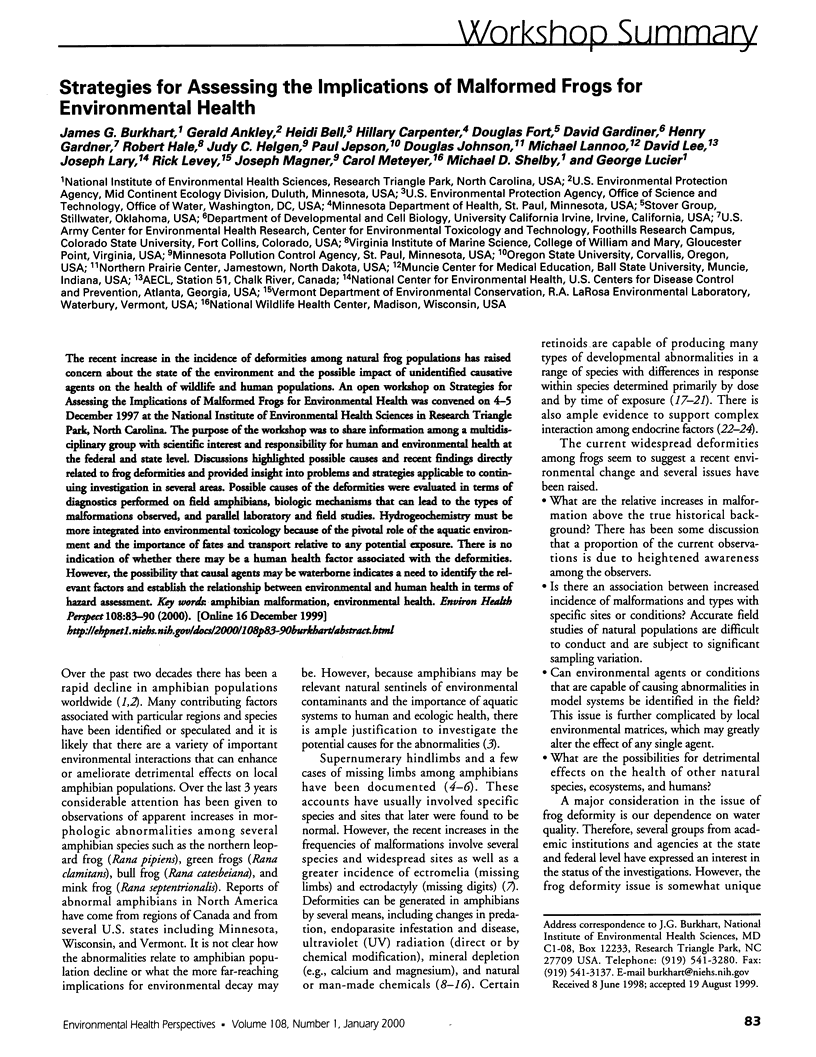

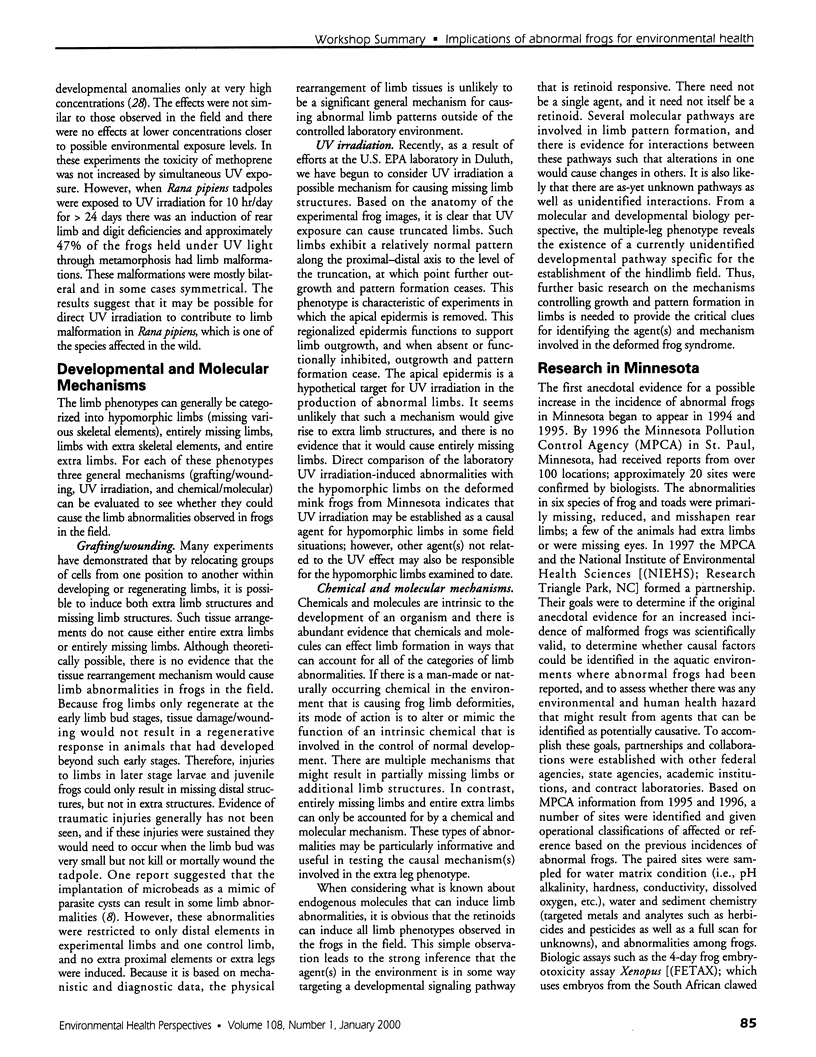
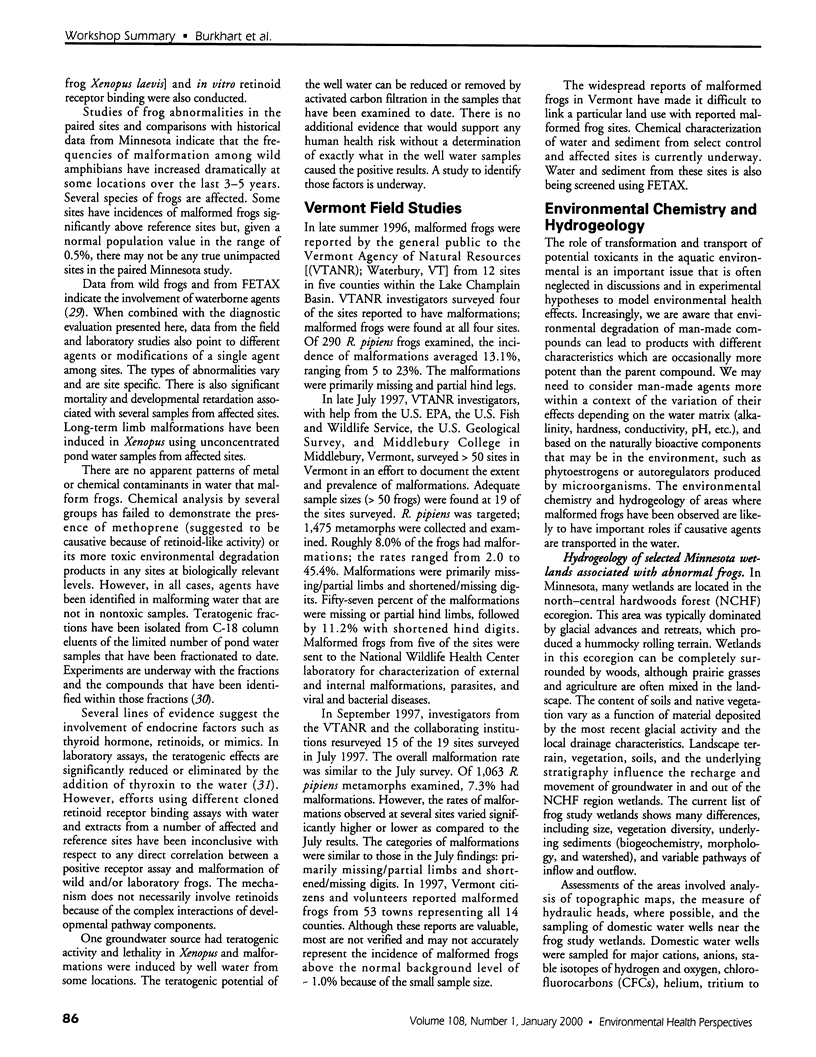
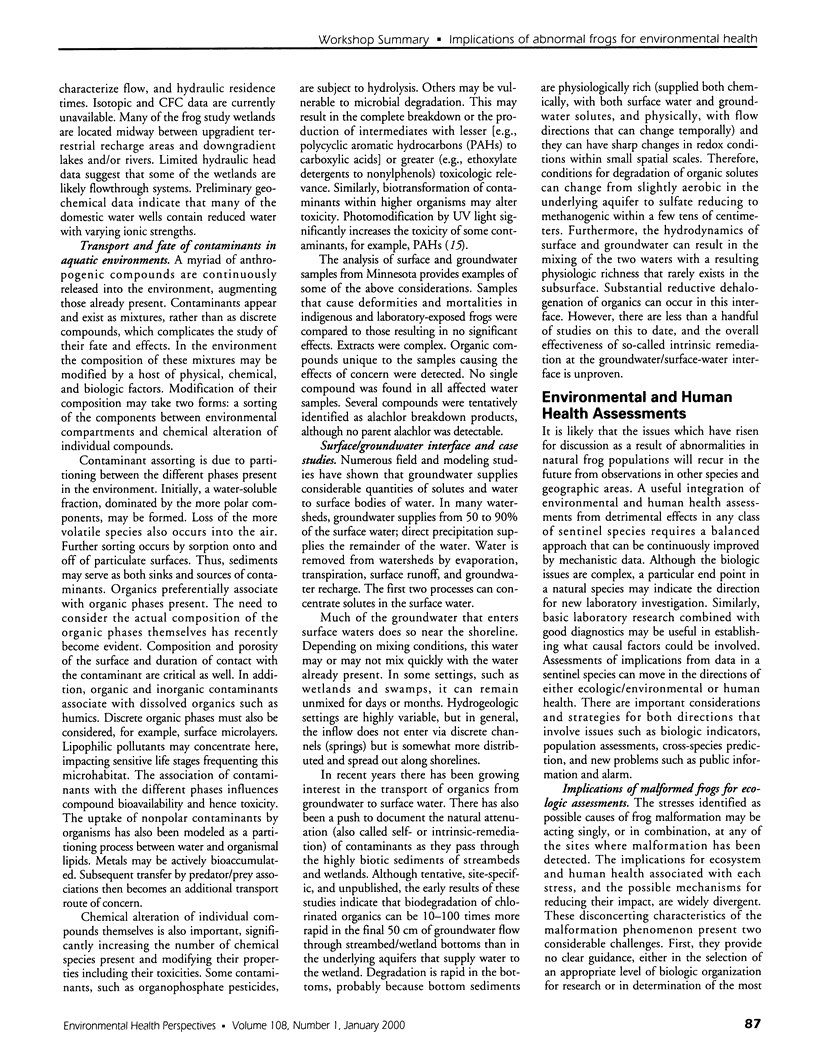
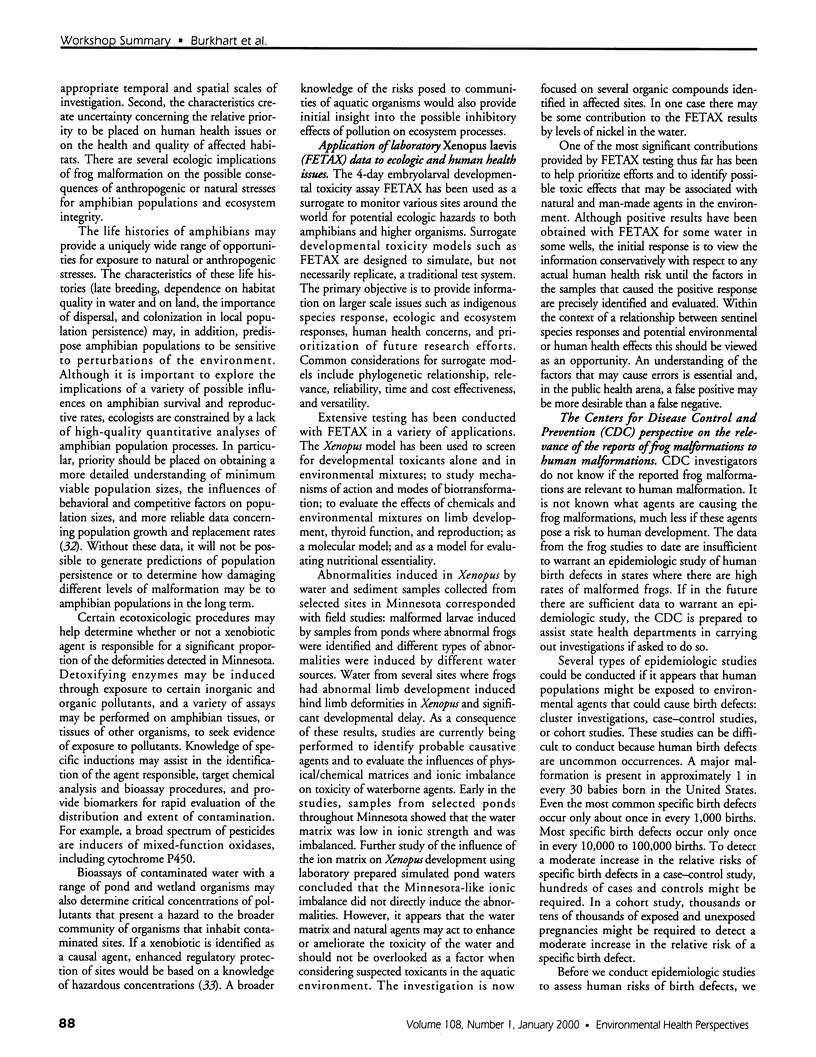
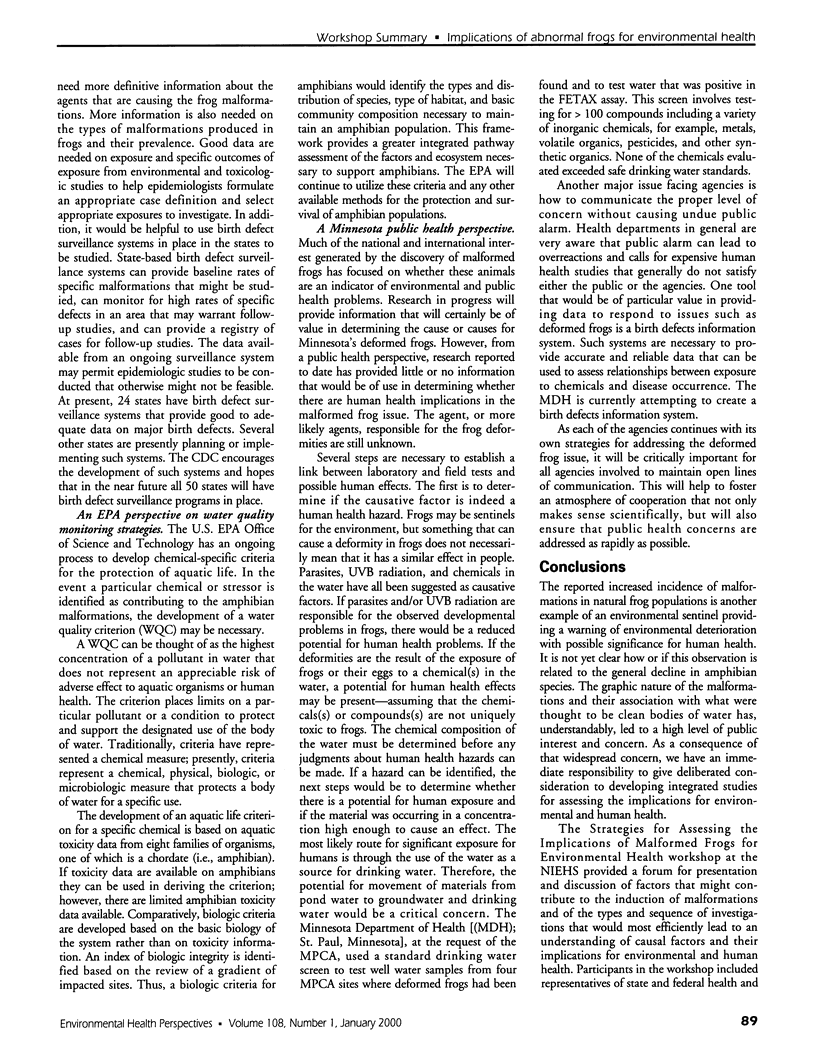
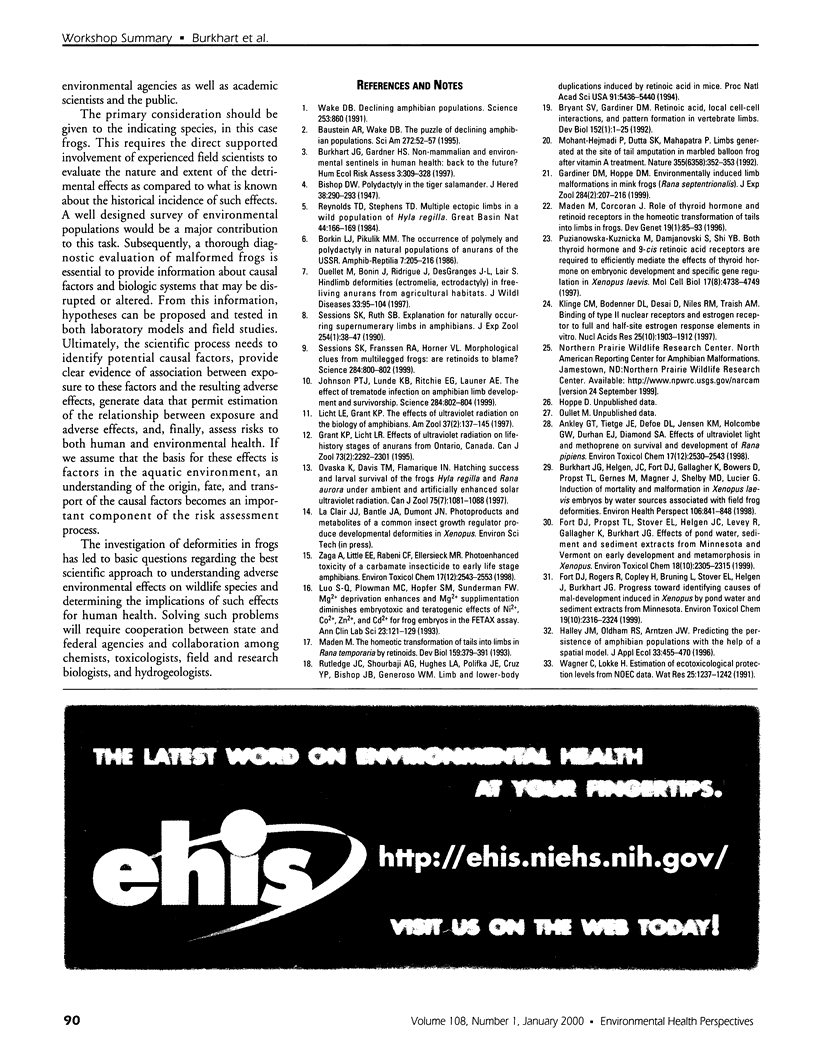
Selected References
These references are in PubMed. This may not be the complete list of references from this article.
- Bryant S. V., Gardiner D. M. Retinoic acid, local cell-cell interactions, and pattern formation in vertebrate limbs. Dev Biol. 1992 Jul;152(1):1–25. doi: 10.1016/0012-1606(92)90152-7. [DOI] [PubMed] [Google Scholar]
- Burkhart J. G., Helgen J. C., Fort D. J., Gallagher K., Bowers D., Propst T. L., Gernes M., Magner J., Shelby M. D., Lucier G. Induction of mortality and malformation in Xenopus laevis embryos by water sources associated with field frog deformities. Environ Health Perspect. 1998 Dec;106(12):841–848. doi: 10.1289/ehp.106-1533234. [DOI] [PMC free article] [PubMed] [Google Scholar]
- Gardiner D. M., Hoppe D. M. Environmentally induced limb malformations in mink frogs (Rana septentrionalis). J Exp Zool. 1999 Jul 1;284(2):207–216. doi: 10.1002/(sici)1097-010x(19990701)284:2<207::aid-jez10>3.3.co;2-2. [DOI] [PubMed] [Google Scholar]
- Johnson P. T., Lunde K. B., Ritchie E. G., Launer A. E. The effect of trematode infection on amphibian limb development and survivorship. Science. 1999 Apr 30;284(5415):802–804. doi: 10.1126/science.284.5415.802. [DOI] [PubMed] [Google Scholar]
- Klinge C. M., Bodenner D. L., Desai D., Niles R. M., Traish A. M. Binding of type II nuclear receptors and estrogen receptor to full and half-site estrogen response elements in vitro. Nucleic Acids Res. 1997 May 15;25(10):1903–1912. doi: 10.1093/nar/25.10.1903. [DOI] [PMC free article] [PubMed] [Google Scholar]
- Luo S. Q., Plowman M. C., Hopfer S. M., Sunderman F. W., Jr Mg(2+)-deprivation enhances and Mg(2+)-supplementation diminishes the embryotoxic and teratogenic effects of Ni2+, Co2+, Zn2+, and Cd2+ for frog embryos in the FETAX assay. Ann Clin Lab Sci. 1993 Mar-Apr;23(2):121–129. [PubMed] [Google Scholar]
- Maden M., Corcoran J. Role of thyroid hormone and retinoid receptors in the homeotic transformation of tails into limbs in frogs. Dev Genet. 1996;19(1):85–93. doi: 10.1002/(SICI)1520-6408(1996)19:1<85::AID-DVG9>3.0.CO;2-X. [DOI] [PubMed] [Google Scholar]
- Maden M. The homeotic transformation of tails into limbs in Rana temporaria by retinoids. Dev Biol. 1993 Oct;159(2):379–391. doi: 10.1006/dbio.1993.1249. [DOI] [PubMed] [Google Scholar]
- Mohanty-Hejmadi P., Dutta S. K., Mahapatra P. Limbs generated at site of tail amputation in marbled balloon frog after vitamin A treatment. Nature. 1992 Jan 23;355(6358):352–353. doi: 10.1038/355352a0. [DOI] [PubMed] [Google Scholar]
- Ouellet M., Bonin J., Rodrigue J., DesGranges J. L., Lair S. Hindlimb deformities (ectromelia, ectrodactyly) in free-living anurans from agricultural habitats. J Wildl Dis. 1997 Jan;33(1):95–104. doi: 10.7589/0090-3558-33.1.95. [DOI] [PubMed] [Google Scholar]
- Puzianowska-Kuznicka M., Damjanovski S., Shi Y. B. Both thyroid hormone and 9-cis retinoic acid receptors are required to efficiently mediate the effects of thyroid hormone on embryonic development and specific gene regulation in Xenopus laevis. Mol Cell Biol. 1997 Aug;17(8):4738–4749. doi: 10.1128/mcb.17.8.4738. [DOI] [PMC free article] [PubMed] [Google Scholar]
- Rutledge J. C., Shourbaji A. G., Hughes L. A., Polifka J. E., Cruz Y. P., Bishop J. B., Generoso W. M. Limb and lower-body duplications induced by retinoic acid in mice. Proc Natl Acad Sci U S A. 1994 Jun 7;91(12):5436–5440. doi: 10.1073/pnas.91.12.5436. [DOI] [PMC free article] [PubMed] [Google Scholar]
- Sessions S. K., Franssen R. A., Horner V. L. Morphological clues from multilegged frogs: are retinoids to blame? Science. 1999 Apr 30;284(5415):800–802. doi: 10.1126/science.284.5415.800. [DOI] [PubMed] [Google Scholar]
- Sessions S. K., Ruth S. B. Explanation for naturally occurring supernumerary limbs in amphibians. J Exp Zool. 1990 Apr;254(1):38–47. doi: 10.1002/jez.1402540107. [DOI] [PubMed] [Google Scholar]
- Wake D. B. Declining amphibian populations. Science. 1991 Aug 23;253(5022):860–860. doi: 10.1126/science.253.5022.860. [DOI] [PubMed] [Google Scholar]


